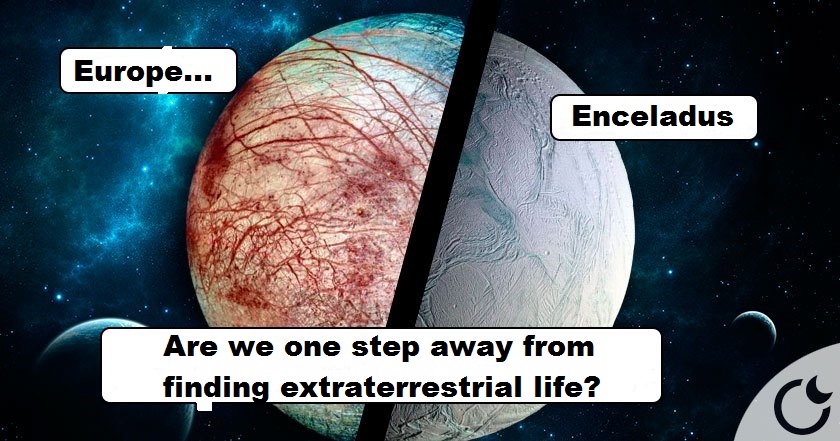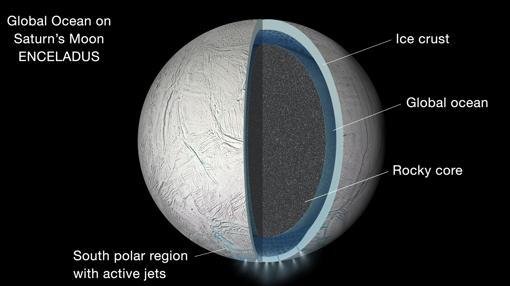NASA BELIEVES THAT THERE IS LIFE on moons of Saturn and Jupiter. LAST MINUTE

In just a few months, NASA's Cassini spacecraft will make history by disintegrating in Saturn's dense, cold atmosphere. With its destruction, it will be the end of a trip of almost two decades in which the small ship has explored the methane seas of Titan's surface, the incredible rings of Saturn and the mysterious surface of Enceladus, a satellite that in its entrails hides a global ocean of liquid water that is rich in organic molecules.
Before exhausting its fuel reserves and shutting down forever, Cassini will give one last surprise. The observations that the probe made in 2015 have supposed an unexpected turn to the search of extraterrestrial life in the Solar System. In an article published Thursday in the journal Science, scientists have once again corroborated that Enceladus is one of the places where it is more likely to find alien life. In the ice geysers on one side of the satellite, researchers have detected the presence of two gases, carbon dioxide and molecular hydrogen, which suggest that Enceladus hosts hydrothermal reactions and a chemical imbalance that are capable of sustaining life .
«This suggests that the ocean has enough chemical energy to support life in the form of microbes»
"This study provides the strongest evidence of a hydrothermal processing of the rocks by liquid water in the interior of Enceladus," explained ABC Hunter Waite, first author of the study and researcher at the "Soutwest Research Institute" (SwRI) ( United States), in the Cassini mission. "Our work also shows that this ocean is energetically habitable, which means that it has enough chemical energy to support life similar to some microbes on Earth."
Enceladus, suitable for living beings
Enceladus is a satellite of Saturn that barely measures 500 kilometers in diameter. It is covered by an icy crust, about 30 or 40 kilometers thick, and its surface is as calm as it is cold. However, its interior seems to be very active. In 2005 NASA discovered that in the southern hemisphere of this world there is a cloud of ice that is formed by the presence of several geysers that eject materials from the "guts" of Enceladus, as if someone had uncorked a bottle of champagne.

Internal structure of Enceladus- NASA / JPL-Caltech
Subsequent studies made this ice sphere a strong candidate to house extraterrestrial life. Thanks to Cassini, the scientists found out that beneath the Enceladus ice lies an underground world inhabited by a rocky core surrounded by a global ocean. It was discovered that in the water there are organic molecules and ammonia in solution, because these go out through the geysers. It was also concluded that the powerful gravity of Saturn generates heat in the bowels of the satellite, providing another key ingredient for the appearance of life.
Power source
Many places in the Solar System are home to the two most fundamental ingredients of life: water and organic molecules. But until now, none of them had found a geological cycle capable of acting as a source of energy for living beings, as explained by Jeffrey S. Seewald in the journal Science. Now, however, Waite's team has found a chemical imbalance that on Earth sustains entire ecosystems.
This makes Enceladus one of the places in the Solar System "most promising in terms of habitability," as explained to ABC Kelly Miller, co-author of the study and also a researcher at SwRI.
Why? "This chemical imbalance is the unequivocal proof that the moon is active and that it houses geological processes capable of producing new materials," Alberto González Fairén, researcher at the Center for Astrobiology (CSIC-INTA), explained to ABC. "It is in such environments where life can have an opportunity, certainly not in geologically dead planetary bodies."
According to Fairén, the fact that this type of process can happen makes Encélado one of the priority objectives for the search for extraterrestrial life. But there are other places of great interest, apart from this satellite. The other priority candidates are still Mars, Europe (a moon of Jupiter) and Titan (another of Saturn's moons).
Life that feeds on hydrogen
Where the sunlight does not reach, as in the depths of Earth's oceans, molecular hydrogen and carbon dioxide are a source of energy for some microbes. These molecules are produced in large part by the reactions that occur naturally between the iron in the minerals of the soil and water. In addition, they are used by some living beings as a kind of "fertilizer".
According to Ricardo Amils, Professor of Microbiology at the Autonomous University of Madrid, on Earth these molecules are used by microbes known as methanogenic archaea (a type of organism similar to bacteria that produce methane gas).
"Both methanogenesis (generation of methane) and hydrogen and carbon dioxide are primitive and primordial," Amils explained. In fact, some seem to be some of the protagonists that allowed the appearance of life on Earth billions of years ago.
«We do not know if the origin of life is inevitable or something that happens only once in the Universe»
Does this mean that in Enceladus there has also appeared a specialized life in consuming that hydrogen and that carbon dioxide? Still not known. "We can not conclude that Enceladus harbors living beings, and it is difficult to make predictions because we do not know if the origin of life is inevitable or something that happens once in the Universe," Waite said. "This is precisely what motivates us to explore more!"
This researcher has recognized that in Enceladus everything is not favorable for life. For example, the presence of sulfur and phosphorus has not yet been detected, two fundamental elements for organisms, since they form a very important part of the proteins and genetic material of living beings.
Ricardo Amils has also clarified that if in Enceladus there were microbes consuming molecular hydrogen and carbon dioxide, they should be producing methane: "The existence of a chemical imbalance as measured does not imply that there is life, but that there can be because we know living beings in the Earth that use it to obtain energy. It would be necessary to detect the product: methane, and demonstrate that it is biological, because geology can also originate it ».
Next mission to Enceladus
We will have to wait to look for possible traces of life in Enceladus. Cassini was not designed to find its trace and, in any case, will no longer fly over the satellite. "We will need a next mission to answer the astrobiological questions that this investigation has awakened. A mission called "Enceladus Life Finder" (ELF) is under study, but is still competing to get its chance to fly, "said Hunter Waite.
What would be the implications of detecting life in this small and remote moon of Saturn? "If life is present in Enceladus, this would forever change the understanding of what place Humanity occupies in the Universe. This study does not take that step, but brings us a little closer to the goal of understanding the livability of the incredible environment of this place, "concluded Waite. Kelly Miller, one of the co-authors of the study, recalled that the search for life beyond Earth must be humble. The reason is that we can not forget that it is very possible that the potential life forms of Enceladus had nothing to do with terrestrial ones. How to know what they need, in that case? The missions of the coming decades promise to be exciting in the search for extraterrestrial life.
THE MOON OF JUPITER EUROPE ALSO COULD HAVE THE CONDITIONS NECESSARY TO HOST LIFE
The possibility of extraterrestrial life is something that has been intriguing scientists for a long time. The planets and satellites of the Solar System have already been, due to their proximity, extensively studied without evidence of the existence of any type of microorganism in any of them. For this reason, looks are increasingly placed on more distant objects in which the perfect conditions could be given to house life.
However, the results of a recent investigation point to a place closer to what we thought was a candidate to house life. It is about Europe, one of the satellites that orbit Jupiter and under whose surface is a huge ocean of salt water. The gravitational tides of Jupiter generate the necessary heat so that the water remains in liquid state under a layer of solid ice of between 10 and 30 km of thickness.
This is how the powerful northern lights of Jupiter are formed
The study published in the journal Geophysical Research Letters defends that this huge ocean could harbor life due to its capacity to generate conditions very similar to those that occur on Earth.
The production of oxygen in Europe is ten times higher than production and hydrogen. For the existence of life there must be a balance between these two gases, something that previously was thought to be generated by the existence of volcanic activity in the satellite, which would produce hydrogen. However, this new study points out, on the contrary, that the production of hydrogen could be formed in another way. Water would generate hydrogen by coming into contact with the core rock of Europe through cracks in its crust, a mechanism that also occurs on our planet.
NASA has a mission to this satellite scheduled for the next decade, thanks to which we could obtain new clues about the conditions of Europe and the possibility that someday we will find life there.
Hi, I found some acronyms/abbreviations in this post. This is how they expand:
Hi. I am @greetbot - a bot that uses AI to look for newbies who write good content.

I found your post and decided to help you get noticed.
I will pay a resteeming service to resteem your post,
and I'll give you my stamp of automatic approval!
Resteemed by @resteembot! Good Luck!
The resteem was payed by @greetbot
Curious?
The @resteembot's introduction post
Get more from @resteembot with the #resteembotsentme initiative
Check out the great posts I already resteemed.
You were lucky! Your post was selected for an upvote!

Read about that initiative